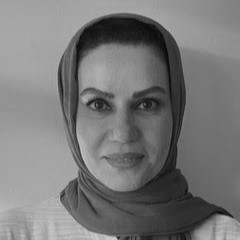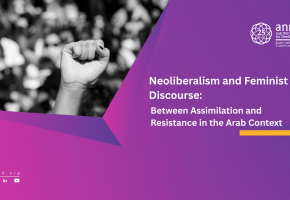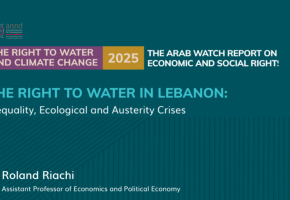
International Protection Mechanisms: Resolution 1325 fails to Protect Women - Elham Makki

International Protection Mechanisms: Resolution 1325 fails to Protect Women - Elham Makki
After all these years, wars and armed conflicts continue. The worst thing is that thousands of women and children are being killed, injured, or barely surviving in completely tragic conditions. Thus, I wondered how our recommendations to address wars, militarization and violence against women could be heard by war makers and governments of oppressive regimes.
"I am sorry, I cannot think of recommendations under the current circumstances," I answered the question on recommendations about what we should do as women activists from countries facing armed conflicts: Iraq, Yemen, Sudan, Syria, and Lebanon. We met to discuss the Women, Peace, and Security (WPS) agenda, attempting to bring a feminist perspective on the ongoing war in Gaza and the military invasion in Lebanon. It is sad and infuriating to think that our discussion during the meeting seemed to happen in a different dimension, far away from the parties and actors controlling the global system that bypasses the basic values of peace and supports the war machine and the international arms trade.
The adoption of UN Security Council Resolution 1325 on Women, Peace and Security on October 31, 2000, represented an unprecedented commitment by the international community to include women in peace processes. With the adoption of the nine subsequent resolutions, the so-called UN Security Council’s “agenda” on women, peace and security was formed. It recognized the heavy costs borne by women and girls as a result of wars around the world and calling for their essential involvement in conflict resolution and peacebuilding efforts from which they have historically been marginalized. However, more than two decades after the adoption of Resolution 1325 and the blatant disregard for international law designed to protect women and children during wars, there is an urgent need to re-evaluate the WPS, particularly after the clear failures to implement it on the ground, despite the widespread rhetoric promoted in international forums and countries that have declared their support for the resolution, including Iraq, which witnesses armed conflicts and wars.
The core objective of Resolution 1325 and subsequent resolutions was to become a framework for preventing violence and discrimination against women. However, implementation mechanisms did not reflect the reality of the feminist peace agenda. Most countries with authoritarian political systems tend to prioritize the security of their political system and their security and military institutions at the expense of individual security and the protection of human rights. The resolution did not address the question of "whose security?" The resolution was non-binding, meaning that countries are not legally obligated to implement its provisions, and are not punished for failing to do so.
It also did not include accountability mechanisms, so even when countries adopt national action plans on UN Security Council Resolution 1325, these plans often resemble empty policy speeches, with little follow-up or monitoring. Countries are not held accountable for their failure to fulfill their obligations to protect women and civilians in general.
On the other hand, the wording of the resolution allows for selective implementation, as Resolution 1325 was not universally adopted, which gave states the signal to select or cherry-pick some of the resolution’s contents to suit their political agendas, often ignoring crucial elements that would meaningfully protect women.
Resolution 1325 also failed to address structural inequalities. Patriarchal and military systems remain unchallenged, reproducing violence and systematic exclusion against women in positions of power. The aim of the resolution’s four pillars is to reduce violence against women and girls and promote their participation in times of peace and war, which requires a shift in power dynamics and the removal of structural barriers to women’s human rights. This neglect has undermined the resolution’s effectiveness, as systemic inequalities and militarization often underpin the violence women are subjected to.
As
conflicts and wars expand, and different forms of violence against women
emerge, the resolution provides a limited scope for “protection” by not
addressing the structural causes of violence. Resolution 1325 often interprets
“protection” as reactive rather than preventive, and fails to address the root
social and economic issues that make women vulnerable in the first place.
Another reason for the resolution’s failure to deliver on its goals and promises is that the focus has been on the elite level in peace processes. While the resolution calls for women’s participation in peace processes, it has often allowed for the inclusion of only a few elite women, rather than empowering local women affected by the conflict who have direct knowledge and a vested interest in peace.
The situation in Iraq provides a critical lens to explore why and how Security Council Resolution 1325 failed. Iraq was the first country in the region to adopt the resolution, developing the first national plan for implementation in 2014, followed by a second national plan in December 2020. However, despite the shortcomings of the two plans in reflecting the daily reality of women and girls in Iraq, the Iraqi government did not fulfill its commitments included in the two plans. The gap remained between the resonant theoretical political discourses supporting the protection and rights of women and the ground situation in addressing the most important and fundamental factors leading to violence against women and girls in Iraq, in peace and in war.
The failure of and shortcomings in implementing Security Council Resolution 1325 in Iraq is attributed to several reasons. They begin with the lack of political will and failure to prioritize funding the plan's implementation by the government. Apart from the arguments presented by the government to allocate state resources to combat terrorism, fight ISIS groups, liberate the areas they controlled, and the economic crises witnessed in the country, the government’s efforts to reduce the conservative cultural and social barriers that reproduce violence against women (which do not require funding) are almost non-existent. Resistance to changing the laws and structural discriminatory practices against women and girls by the ruling political forces continued. In fact, the situation has become worse than before, as women face threats and attempts to undermine the gains in rights protected in some laws. The attempt by the ruling political forces to change the Personal Status Law (188) of 1958 would lead to depriving women of human rights and entrenching violent practices against them, such as marrying off girls, depriving them of inheritance, and depriving women of custody. It is further evidence and an indication of Resolution 1325 losing importance and failing to achieve its goals of protecting Iraqi women.
Finally, women's security and feminist peace cannot be detached from international security and peace. Definitions of conflict, peace ,and security must be read as conditions that also relate to situations outside conflict zones. This generalization makes prioritizing root causes and human rights a means to focus on effective conflict prevention. It starts from an understanding of the widespread and deep insecurity that pervades women’s lives before conflict and the pre-conflict structural inequalities that feed violence and insecurity, a reminder of the need for comprehensive transformation rather than random action.
Recent publications

Neoliberalism and Feminist Discourse: Between Assimilation and Resistance in the Arab Context
